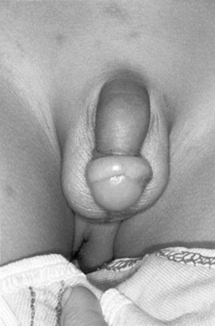Chapter 49 Urologic Emergencies
5 Describe the difference between phimosis and paraphimosis
Both of these conditions are seen in the uncircumcised male. Phimosis occurs when the distal foreskin is too tight to retract over the glans penis. Paraphimosis occurs when the foreskin is left in the retracted position, becomes swollen and edematous, and is then unable to be reduced (Fig. 49-1). Phimosis is not generally a problem in children, and is normal in boys younger than 6 months. Frequent retraction of the foreskin should not routinely be attempted in infants. In contrast, paraphimosis should be reduced. This is generally accomplished by application of lidocaine gel to the swollen foreskin, followed by steady pressure on the glans. Then pull the foreskin forward while pushing the glans backward with the thumb, as you would to turn a sock inside out. A dorsal penile block with local anesthetic may make the patient more comfortable, but it is generally not needed.
8 How do a “communicating” and a “noncommunicating” hydrocele differ?
Brenner J, Ojo A: Causes of painless scrotal swelling in children and adolescents: www.uptodate.com
18 List the variables that have optimal diagnostic accuracy in diagnosing UTI in young females
Note: Three or more of the above have the best accuracy in making the diagnosis.
29 Which patients with UTI should be admitted for parenteral antibiotics?
Hoberman A, Wald ER: Treatment of urinary tract infections. Pediatr Infect Dis J 18:1020–1021, 1999.
38 Which patients with urolithiasis need to be admitted?
Bartosh S: Medical management of pediatric stone disease. Urol Clin North Am 31: 575–588, 2004.








